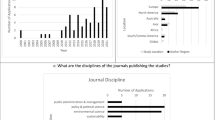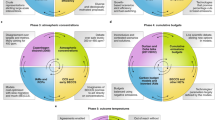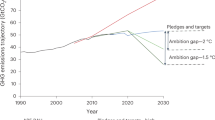Abstract
Evidence is mounting that the 1.5 °C goal of the Paris Agreement is unrealistic. But, contrary to many in the scientific community, major NGOs have remained steadfast in their support for this target. We argue that this is because “unrealistic” or aspirational targets can serve important political objectives, including becoming focal points for coalition-building and broad-based mobilization and allowing for effective naming and shaming.
Similar content being viewed by others
Introduction
The 2015 Paris Agreement adopted the aspirational target to limit the temperature increase to 1.5 °C above pre-industrial levels. Eight years later, evidence is mounting that the target is unrealistic1. Nature’s survey of IPCC authors found that only 4% of scientists predict global warming will be limited to 1.5 degrees by the end of the century2. The 2022 UN Emissions Gap Report came to the same conclusion, finding that 1.5 degrees is not credible3. A science-based network called “Scientist Rebellion” has collected over 1,000 signatures on a public letter demanding the scientific community “make clear the inevitability of missing the 1.5 °C goal”4.
For many scientists, “keeping 1.5 alive” provides a sense of false hope, and thus provides political cover for corporations and national governments to delay decarbonization. If 1.5 °C is abandoned, perhaps greater political mobilization might be possible for the 2 °C target before it slips away as well. Writing in 2022, commentator Bill McGuire observed that the 1.5 °C target “is at best, irrelevant, and at worst, dangerous”5.
Yet, major NGO and civil society networks participating in advocacy at the UNFCCC remain steadfast in their support for the 1.5 °C goal. During COP 28, the Climate Action Network — the largest civil society coalition of over 1900 organizations in 130 countries—called for mitigation action consistent with a 1.5 °C pathway6. The statement from Global Youth argued that “ensuring intergenerational climate justice requires meeting the 1.5 °C guardrail”7. And the Indigenous Peoples Organizations constituency also affirmed the importance of the 1.5 °C target8.
Why are some NGOs taking a different position from that of many in the scientific community on the 1.5 °C target? As political scientists who study social movements, we recognize that “unrealistic” or aspirational targets like 1.5 °C serve two important political objectives.
1.5 °C as a focal point for coalition-building and mobilization
NGOs and social movements seek to build broad coalitions to mobilize large numbers of people and demonstrate widespread support9. The 1.5 °C goal is valuable to NGOs and climate social movements because it has allowed them to build strong coalitions among different components of the movement.
The push to reorient goal setting from 2.0 °C to a 1.5 °C goal first started in 2009 as the result of the advocacy of the Alliance of Small Island States [AOSIS]10, which viewed 2.0 °C as an existential threat and “the objective of the rich countries”11. After extensive diplomacy—and with the support of NGOs and foundations, and the re-alignment of the “High Ambition Coalition”—1.5 degrees was adopted as an aspirational goal in the Paris Agreement in 201512.
The 1.5 °C target aims to reduce the risk of the worst climate outcomes, which tend to hurt vulnerable and disadvantaged nations and communities. As such, it brings together two components of a climate movement that have in the past been divided: those groups with a history of environmental advocacy and those rooted in social justice organizing13. 1.5 °C marries together the commitment to climate justice with a desire to increase environmental ambition, merging these movements with a unified demand.
Moreover, a commitment to 1.5 °C allowed the climate movement to deploy a justice-based framing of the issue14, which is especially likely to resonate with participants and draw them into mobilization15. Moreover, it connects with broader justice concerns that have emerged around race and gender. If climate stakeholders (or a subset of them) were to accept a more “realistic” target of 2.0 °C, that could undermine their justice-based claims, weaken their mobilization, and fragment their alliance.
1.5 °C target as the basis for naming and shaming
NGOs and social movements exert power through their direct influence on leaders and public opinion. Ample research in human rights16 and climate change17,18 has demonstrated the influence of “naming and shaming” on both diplomats and the public. At COP 28, for example, The Climate Action Network used the 1.5 °C target to name and shame particular countries whose actions on mitigation were considered inconsistent with this goal19.
But the strategy of naming and shaming relies on the existence of clear behavioral standards or “norms” to which actors can be held accountable. Research shows that it is easier for states to justify norm violation if the norm contains multiple parameters or is made ambiguous20. Thus, if 1.5 °C is discarded due to a lack of realism, it will become easier for governments and corporations to justify delays in decarbonization—and harder for NGOs and social movements to hold them accountable. In the future, it also opens the door for the 2.0 °C target to be abandoned, as norm violation will have already been routinized. Thus, from a social movement perspective, it is imperative to defend the 1.5 °C target, which allows civil society to pressure governments and corporations that are not engaging in behavior that is consistent with the agreed-upon Paris goal.
Scientists and NGOs operate with different political constraints. For the former, abandoning the 1.5 °C target is scientific updating, a normal part of the scientific process. For NGOs, however, it is goal abandonment and the undermining of a crucial mobilizing issue. It is an open debate about which approach will better serve public climate policy goals: whether more realistic objectives will mobilize public opinion and policy attention, or whether aspirational targets are better suited for this task. This should not be viewed as a clash between scientists and NGOs, but as an example of the diversity of the climate coalition, which is united in its final goal, but differs in terms of its tactical approaches. Future discussions between these coalitions of scientists and NGOs might focus on areas of possible consensus that meet each of their political needs, such as the establishment of intermediate targets or sectoral goals.
Reporting summary
Further information on research design is available in the Nature Research Reporting Summary linked to this article.
Data availability
Data sharing is not applicable to this article as no datasets were generated or analyzed during the current study.
Code availability
Code sharing is not applicable to this article as no datasets were generated or analyzed during the current study.
References
Harvey, C. & E&E News. “The World Will Likely Miss 1.5 Degrees C—Why Isn’t Anyone Saying So? Sci. Am. https://www.scientificamerican.com/article/the-world-will-likely-miss-1-5-degrees-c-why-isnt-anyone-saying-so/ (2022).
Tollefson, J. Top climate scientists are sceptical that nations will rein in global warming. Nature News Feature 599, 22–24 (2021).
United Nations Environment Program. Emissions Gap Report 2022. https://www.unep.org/resources/emissions-gap-report-2022 (2022).
Scientist Rebellion. How Much More Climate Failure Until We Act. https://scientistrebellion.org/sign/ (2024).
McGuire, B. The 1.5C climate target is dead – to prevent total catastrophe, Cop27 must admit it. The Guardian https://www.theguardian.com/commentisfree/2022/nov/12/climate-target-cop27-breakdown-fossil-fuel (2022).
Climate Action Network International. Annual Policy Document: “COP 28: Toward Systems Transformation for a Just and Equitable Future,” p. 4. https://climatenetwork.org/wp-content/uploads/2023/11/COP28-APD_Toward-Systems-Transformation-for-a-Just-and-Equitable-Future_Nov-2023.pdf (2023).
YOUNGO Official Youth Constituency of the UNFCCC. Global Youth Statement: Declaration for Climate Justice, p. 7. https://www.coy18uae.org/global-youth-statement (2023).
Indigenous Peoples Organizations Official Constituency of the UNFCCC. Intervention by Sara Olsvig, Inuit Circumpolar Council in the High-Level Segment of COP 28. https://unfccc.int/sites/default/files/resource/IPOcop28cmp18cma5_HLS_EN.pdf (2023).
Van Dyke, N. & Amos, B. Social movement coalitions: formation, longevity, and success. Sociol. Compass 11, e12489 (2017).
Livingston, J. & Rummukainen, M. Taking science by surprise: the knowledge politics of the IPCC Special Report on 1.5 degrees. Environ. Sci. Policy 112, 10–16 (2020).
Cointe, B. & Guillemot, H. A history of the 1.5 Degree C target. WIREs Clim. Change 14, e824 (2023).
Cointe, B. & Guillemot, H. A history of the 1.5 Degree C target. Pg. 3. WIREs Clim. Change 14, e824 (2023).
Hadden, J. Networks in Contention: The Divisive Politics of Climate Change. (Cambridge University Press, 2015).
Allan, J. & Hadden, J. Exploring the framing power of NGOs in global climate politics. Environ. Politics. 26, 600–620 (2017).
Dolšak, N. & Prakash, A. Three faces of climate justice. Ann. Rev. Pol. Sci. 25, 283–301 (2022).
Krain, M. J’accuse! does naming and shaming perpetrators reduce the severity of genocides or politicides? Int. Stud. Quarterly 56, 574–589 (2012).
Annenberg, A., Lumkowsky, M., Carlton, E. & Victor, D. Naming and shaming as a strategy for enforcing the Paris Agreement: The role of political institutions and public concern. PNAS 120, e2305075120 (2023).
Tingley, D. & Tomz, M. The effects of naming and shaming on public support for compliance with international agreements: an experimental analysis of the Paris agreement. Int. Organ. 76, 445–468 (2021).
Climate Action Network International. COP 28: New Path to Transition Away from Fossil Fuels Marred by Lack of Finance and Loopholes. https://climatenetwork.org/2023/12/13/new-path-to-transition-away-from-fossil-fuels-marred-by-lack-of-finance-and-loopholes/ (2023).
Shannon, V. P. Norms are what states make of them: the political psychology of norm violation. Int. Stud. Quarterly 44, 293–316 (2002).
Acknowledgements
This study received no funding.
Author information
Authors and Affiliations
Corresponding author
Ethics declarations
Competing interests
The authors declare no competing interests.
Additional information
Publisher’s note Springer Nature remains neutral with regard to jurisdictional claims in published maps and institutional affiliations.
Supplementary information
Rights and permissions
Open Access This article is licensed under a Creative Commons Attribution 4.0 International License, which permits use, sharing, adaptation, distribution and reproduction in any medium or format, as long as you give appropriate credit to the original author(s) and the source, provide a link to the Creative Commons licence, and indicate if changes were made. The images or other third party material in this article are included in the article’s Creative Commons licence, unless indicated otherwise in a credit line to the material. If material is not included in the article’s Creative Commons licence and your intended use is not permitted by statutory regulation or exceeds the permitted use, you will need to obtain permission directly from the copyright holder. To view a copy of this licence, visit http://creativecommons.org/licenses/by/4.0/.
About this article
Cite this article
Hadden, J., Prakash, A. The value of unrealistic targets: why some climate activists are unwilling to abandon the 1.5 °C target. npj Clim. Action 3, 29 (2024). https://doi.org/10.1038/s44168-024-00118-0
Received:
Accepted:
Published:
DOI: https://doi.org/10.1038/s44168-024-00118-0



